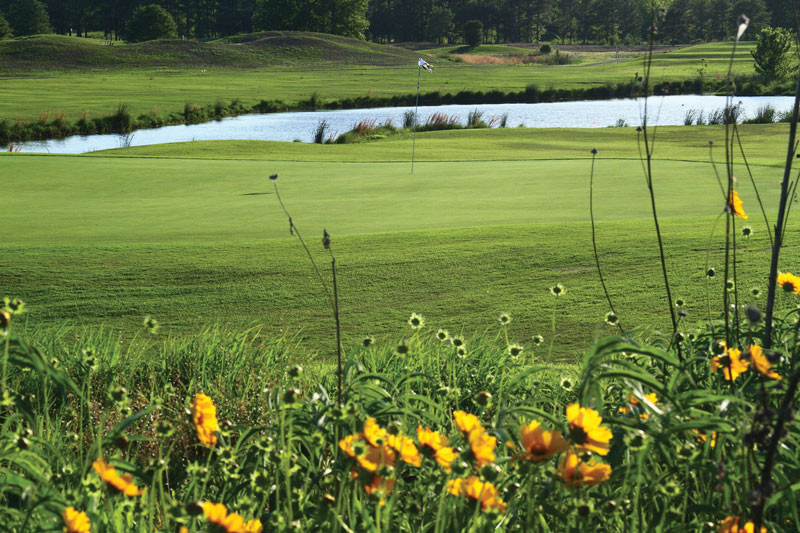
Ben Geren Golf Course in Fort Smith, Ark., will feature roughly 100 acres of native grasses and wildflowers when its prairie restoration project is completed next year. Photo by Jay Randolph
When Jay Randolph, CGCS, became the superintendent at Ben Geren Golf Course, a public 27-hole facility in Fort Smith, Ark., in 2016, he realized he lacked sufficient staffing to maintain the 311-acre course.
The 22-year GCSAA member took this challenge as an opportunity to save on labor and input costs through embracing the Natural State’s natural beauty.
Ben Geren GC, which the facility’s website calls a “mix of woods and water with exceptional bermudagrass fairways and undulating bentgrass greens,” contains four areas of “remnants” of the Massard Prairie that once covered more than 10,000 acres in western Arkansas with native grasses such as big bluestem, little bluestem, switchgrass and Indiangrass.
While less than 1 percent of native tallgrass prairie endures, the four remnant areas total 40 acres of rough at Ben Geren. Randolph saw going back to the course’s prairie roots as the answer to his maintenance issues and an eco-friendly, sustainable course management plan.
“These areas were mowed in the past with a bush hog a couple times per year,” he says. “Now, we let them grow out.”
Randolph and his brother, Christopher Randolph, CGCS, a 22-year GCSAA member and superintendent at The Trails in Norman, Okla., went to Prairie Dunes Country Club outside Hutchinson, Kan., to get some ideas for how the golf course could play up its prairie roots.
Jay wanted to use local grass seed, but not a lot proved to be available. He reached out to the U.S. Department of Agriculture’s Natural Resource Conservation Service and the Arkansas Game and Fish Commission to build relationships for support in the restoration project. The commission’s Acres for Wildlife program provides technical assistance, seed and herbicides to help restore native vegetation.
“Lots of professors and restoration professionals from around the country have given us advice on the restoration and reconstruction work,” Randolph says.
There are about 200 acres of Massard Prairie left across the region, Randolph says, so he got permission to collect grass seed from those sites for seeding at Ben Geren.
In addition to the remnant areas, Randolph says there are a little more than 80 acres at the course undergoing reconstruction, where bermudagrass is being replaced with native grasses and wildflowers. In these areas, the maintenance crew applies herbicide and conducts prescribed burning to eradicate invasive plants — such as Japanese honeysuckle, sericea lespedeza and tall fescue — before seeding native grasses and wildflowers. The course will sport roughly 100 acres of native remnant restoration plus reconstruction areas when the project concludes next year.
Randolph coordinated with the golf pro in marking reconstruction areas with red spray to see whether golfers tended to hit shots into the proposed areas. “The pro shop did a great job communicating what the red areas signified to golfers before and after their rounds,” he says. “If they hit their ball in the red dye a lot, we had proposed native areas in the wrong place. We did end up adjusting a few areas.”
Last year, Ben Geren remnant areas provided the Audubon Arkansas NATIVE (Native Agriculture to InVigorate Ecosystems) project with wildflower seeds for prairie blazing star, rough blazing star, ashy sunflower, rattlesnake-master and compass plant, Randolph says. Collected seeds were sent to Roundstone Native Seed LLC for cleaning and sorting. The seed is then given to low-income farmers to grow for seed harvest. The NATIVE project aims to have enough seedstock for future restorations using Arkansas native seeds, Randolph says. “We are very proud to be part of this ongoing, important work,” he says.
The native grassland restoration has opened up the course, which is part of Ben Geren Park, to multiuse recreational activities. A trail cut through remnant areas allows nature walkers, bird watchers and photographers an up-close look at native plants and the wildlife they attract.
Three types of milkweed at the course are a big draw for pollinators, such as monarch butterflies, Randolph says. The project also creates a habitat for the rattlesnake-master borer moth, which the EPA has judged to be at risk. The moth is named for its reliance on the prairie plant, which is its only food source.
Two coveys of bobwhite quail — a species that has disappeared from much of its range, according to the National Audubon Society — have established a presence at Ben Geren. “There was not a single one on the golf course before the project,” Randolph says.
Randolph gave a presentation about the Ben Geren prairie project at an Arkansas GCSA meeting in March. He says a handful of superintendents are talking with the Arkansas Game and Fish Commission about increasing native habitat on their own courses and taking on possible prairie restorations.